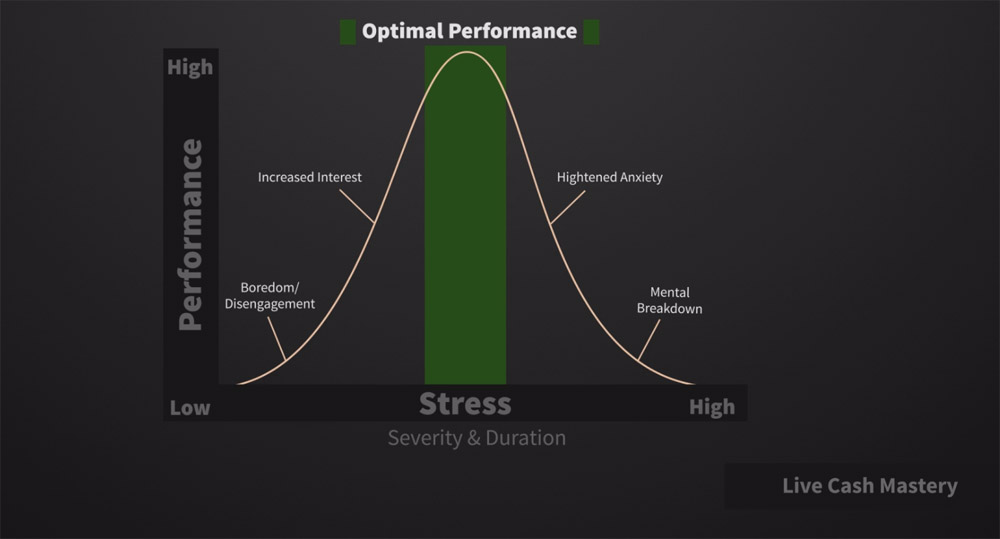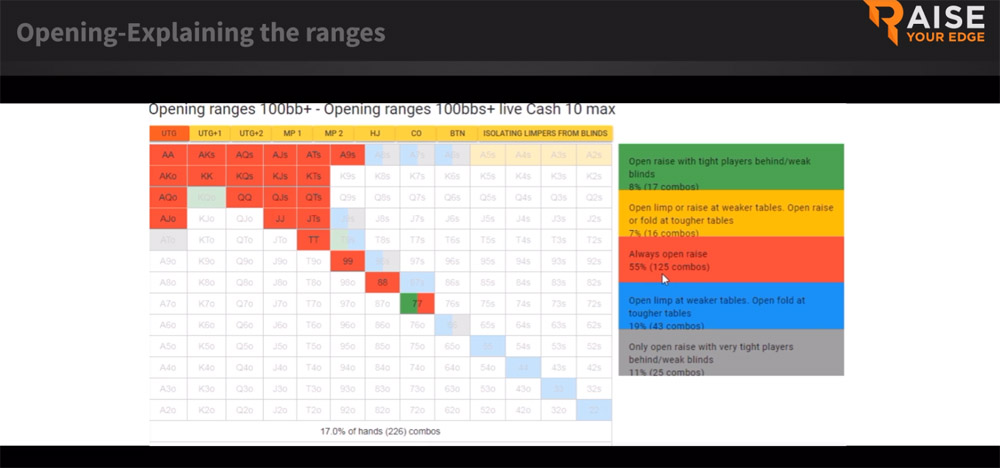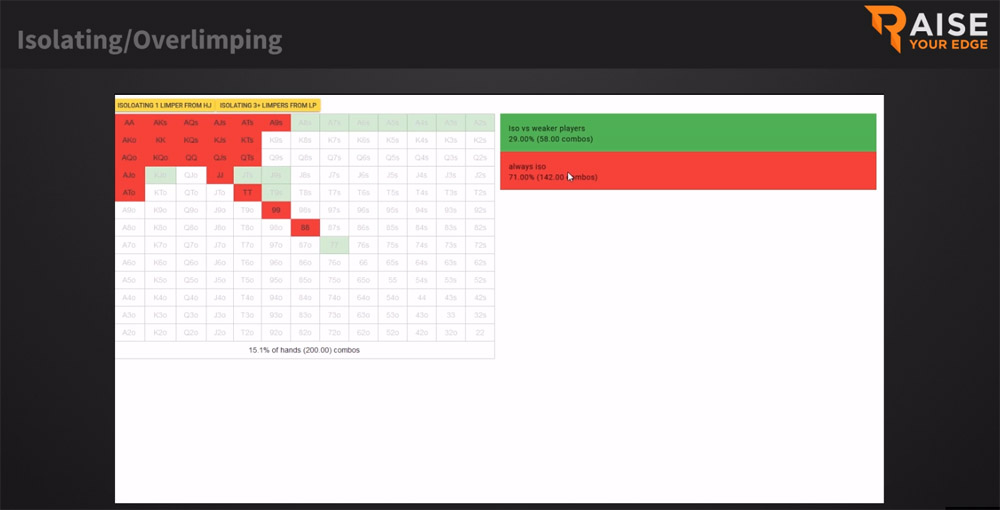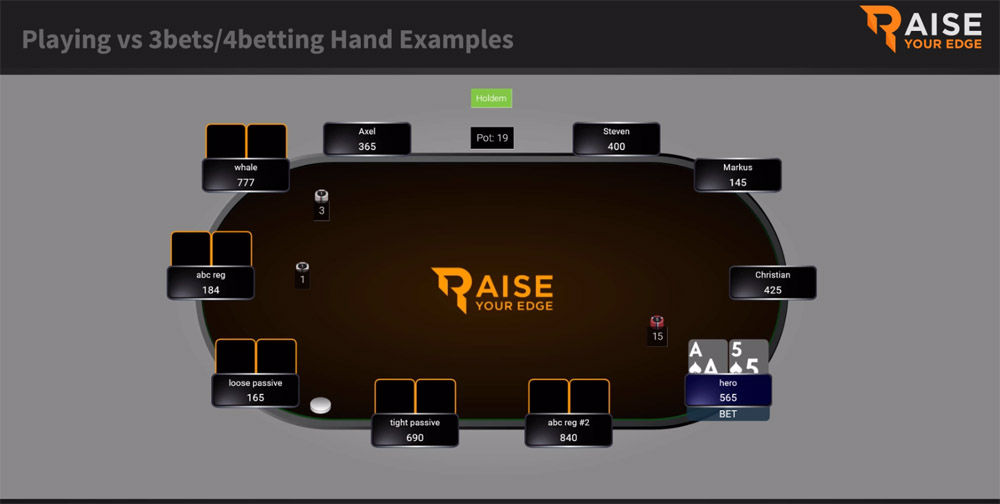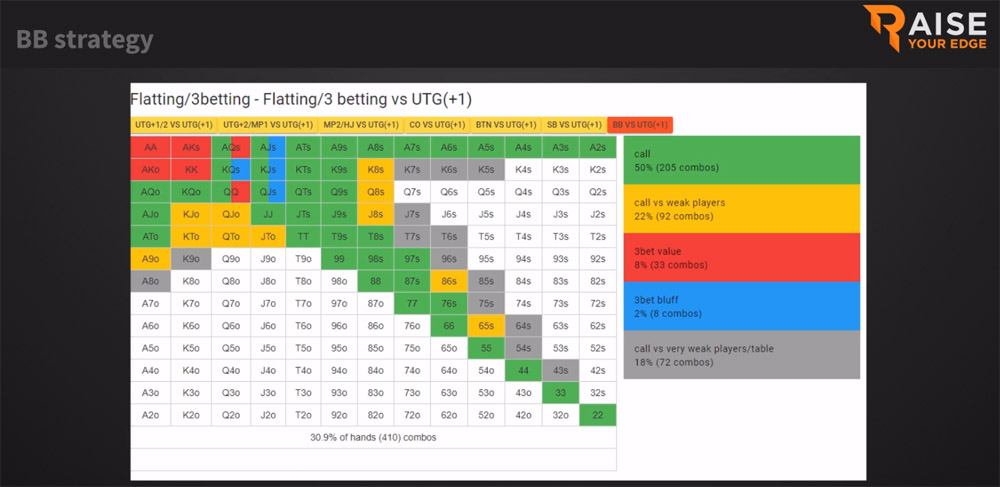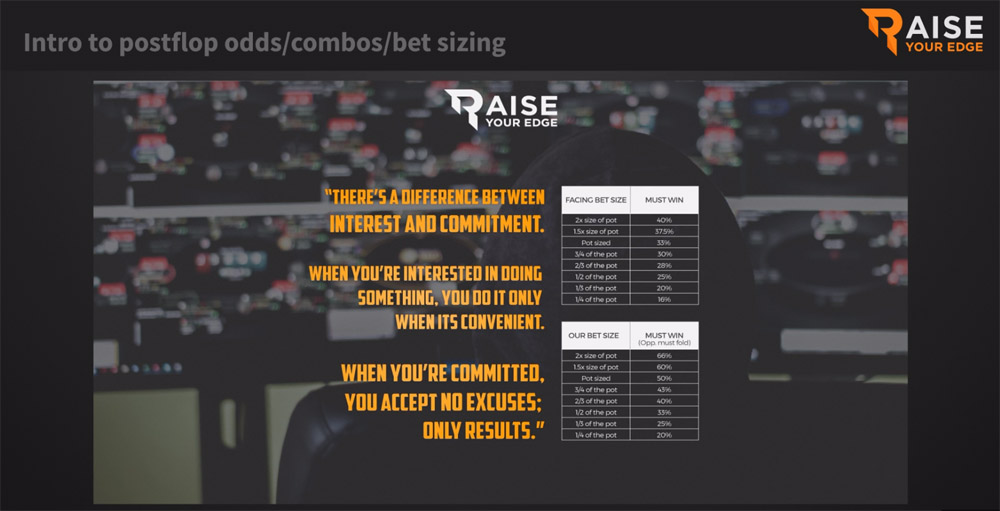Although poker is poker whether you play it sitting behind your computer or live at a local casino, there are some significant differences between live and online games. If you’re thinking about venturing into the world of live cash games, the Mastering Live Cash course from Raise Your Edge might be exactly what you need.
Created by “Fallout86” and “Mariano5” this course explains everything you need to know about playing live cash in today’s environment from all angles. It also teaches you a very solid fundamental strategy that should help you achieve good win-rates on all stakes up to NL500 or so.
The RYE Mastering Live Cash course is divided into two main sections: preflop and postflop play. Each of these sections is further broken down into smaller strategic areas explaining, sometimes to painstaking details, different situations and scenarios.
The general vibe is that Mastering Live Cash isn’t a super-advanced course and you won’t find complex math or solvers inside. It’s more targeted at players dedicated to getting better at live cash, whether they’re just starting or they’ve been playing for a while but without a structured training plan.
The course begins with some simple, fundamental aspects of live poker and then develops and expands gradually. All lessons represent a mix of theory, practical hand examples, and short quizzes, so each unit is fully rounded.
Note: Out of the 103 poker training sites are live on the internet today (yes, I looked), I believe Raise Your Edge are the best poker training sites on the market. If you would like to see my full list of the top poker training resources, check out my linked post.
Table Of Contents
Approaching the Game & Poker Mindest
The first couple of videos in this course address some of the most important questions that every poker player needs to answer before they can fully commit to the grind. The first video tries to get you thinking about your reasons for playing poker and the expectations you have from the game.
How you approach the game will define your success in the long run. Poker can provide you with a nice living but only if you’re willing to put in the work and effort.
This video also talks about differences between live and online games, most importantly a big skill gap that exists. Live games of same stakes are usually much softer than their online counterparts and often include more random plays and recreational players, which requires certain specific adjustments in all areas.
You’ll also get some useful tips and pointers about general things such as table etiquette, bankroll management, and how to create a positive atmosphere at the tables. These aspects are often overlooked and understated so it’s nice to see the team at Raise Your Edge gave them some time and space in this course.
The second video continues on the first one and talks about the poker mindest and why it is so important for the long-term success in the game.
Poker, in all its formats, comes with inevitable stress and a certain degree of pain. Everyone experiences periods of bad variance and losing stretches. It’s how you deal with these things that will define you as a player.
This video provides some useful, hands-on tips on how to handle these situations, how to avoid tilt, and stay calm in face of adversities. Cutting your sessions short whenever you’re feeling overwhelmed is the easiest solution but it’s not the best one as you want to spend as many hours as possible playing your best game.
Preflop Play
Following these intial thoughts, Mastering Live Cash moves on to actual strategy. As with most poker courses, the first part of the series deals with preflop, going through a number of different areas. I won’t go into too much detail on each of them but I’ll try my best to give you a good idea of what to expect inside.
Opening Ranges
Even though every poker player knows how important it is to have solid opening ranges, this often gets forgotten. In live cash games, have very good and strong opening ranges is essential as this alone can give you a big edge over the competition.
While this approach does make your life easier as you don’t have to deal with so many tough decisions after the flop, you still need to be flexible. In live games, it’s important to be aware of the table and figure out the flow. Once you figure it out, you can adjust accordingly, expanding or tightening your opening range but always staying close to fundamentals.
Inside these lessons you’ll also find opening charts for different positions. These charts are presented in the videos and explained in detail, including different adjustments you can make based on the type of the table you’re at.
Isolating & Overlimping
In live games, there is much more limping going on than online. Since limping is such a big part of the game, you need to develop adequate strategies to deal with it.
Usually, you’ll want to isolate against limps, especially when in position. However, to do it right, you need to consider the player who is limping and understand their limping range. Fun, recreational players usually have much wider limping ranges while solid regulars may not have a limping range at all, at least from early positions.
In these videos, the Mastering Live Cash course teaches you about how to properly size your isolation raises with consideration to stack sizes, players’ perceived posflop siklls, and other important factors.
Depending on table dynamics, there will be situations where you’ll just want to limp along with several limpers in front of you instead of isolating. You’ll learn what hands play best in these scenarios as well.
To wrap the module up, there is a video containing quite a few examples of these situations and in-depth explanations of what you should or shouldn’t be doing in certain spots. If there are still some things that aren’t clear after watching the theoretical part, these practical examples should help resolve any doubts.
Flatting, 3-betting, and 4-betting
This is one of the bigger modules in the RYE Mastering Live Cash course as it deals with a rather extensive area of live play. Videos contained inside will teach you things such as:
- What hands to flat call with?
- What hands to 3-bet with?
- How to play against a 3-bet?
When it comes to flatting, course makers suggest an exploitative approach, which usually works best in live games. Consider the player you’re up against, what your implied odds are (they’re always lower against good opponents), and always think about your position. You’ll learn a lot about implied odds required to make calls with different hand categories like small suited connectors, small vs. middling pocket pairs, etc.
3-betting
There is a lot of incentive to 3-bet in poker: it allows you to get more money in the pot when you have a big hand, it gives you the initiative going to the flop, and can get better hands to fold, winning you the pot.
However, in live games, it’s important to have a more linear approach to 3-bets and be more on the value side. This doesn’t mean that you shouldn’t bluff but live players aren’t as keen to fold so your bluff equity won’t be as good in a vacuum.
Of course, there are many things to consider, such as the skill level of the player (are they capable of folding to a 3-bet?), stack sizes, and how the table plays in general.
I do think that Mastering Live Cash brings up some very good points about 3-betting in live games, especially when advocating very few pure bluffs and sticking to semi-liner ranges, i.e. using hands that have decent equity as bluffs. At lower stakes, players just hate folding so there is simply no need to light your money on fire by making wild 3-bet bluffs.
Playing vs. 3-bets
The strategy suggested for playing vs. 3-bets is a very healthy one and it’s easy to implement. Staying true to the general framework, RYE’s Mastering Live Cash course is keeping things simple and straightforward in this area as well.
Instead of giving complicated numbers or formulas, the video talks about the importance of position and understanding the kind of opponent you’re up against. This information will tell you all you need to know about whether to fold, call, or 3-bet.
In live games, where you don’t have access to stats and numbers collected over thousands of hands, this approach works best. It may not sit well with GTO crowd but the fact is, at lower stakes, GTO poker is definitely winning poker but it doesn’t necessarily have to be the most profitable approach. In most games, exploitative is the way to go.
Important topic as 3-bet pots are big so you need good strategy.
Playing from the Blinds
The final module covering preflop play deals with the blinds. This is another important topic and the one that many live players struggle with.
More focus is put on the small blind as this is a more complex position. Calling is almost never a good option because even if you get to the flop, you’ll have a bad position and it will be hard to realize your equity (see this article by Pokernerve for an explaination of equit realization). And quite often, you’ll get squeezed by the big blind. So, how you should approach this problem by creating a solid 3-betting strategy to make your SB range uncapped?
Playing from the big blind is generally easier as you’ll be able to call much more frequently as you’ll often be the one closing the action and you’ll be getting a good price. But even with all that, you should devise a more complex strategy to keep your opponents guessing.
Finally, like in many other videos, you’ll find some good charts for the play from the blinds, further explaining how to best construct your ranges in these spots against different positions at the table.
Postflop Play
The second part of the Raise Your Edge Mastering Live Cash course deals with postflop and it is, as expected, somewhat more comprehensive as there is more ground to cover.
The first video in this section explains some basic concepts about postflop that are valid for all forms of poker, live or online. It brings tables with numbers and percentages to give you a good idea about how often your bets need to win in various spots to make them profitable.
The video also touches on combinatorics, i.e. explains all the different combinations you need to think about in a particular spot and how these calculations work. It’s a very good and detailed explanation that you’ll definitely find useful, especially if you’re new to this concept.
This video also reiterates the importance of understanding different player types found in live games, such as good aggressive players, tight passive types, bad loose passive players, maniacs, etc. It also cautions against overgeneralization and jumping to conclusions based on the looks or a small sample of hands.
Flop Play in Single Raised Pots
This is another big segment of the course featuring several videos covering play on the flop, both as the aggressor and as the caller. You’ll find extensive explanations on how to construct your game when playing in position and out of position in various scenarios.
This is a huge segment of play so it is no surprise this particular section of the course is so extensive. Take the time to go through theory videos and accompanying hand examples. It’s definitely a lot of material so do it at your own pace.
3bet & 4bet Pots
This segment of the course focuses specifically on the flop play in 3-bet and 4-bet pots and it once again covers both sides, i.e. how to approach things when you’re pushing the action and how to handle them when you’re the caller.
Once again, the course emphasizes the importance of live reads and any knowledge you have about your opponent in these spots. Based on this knowledge, you can plan your strategy, deciding whether to c-bet or not (depending on how likely your opponent is to punish you for it).
When you’re the caller, you can also exploit opponents’ tendencies a lot. Just one example from the video is that you can simply adjust by over-folding against tight players that don’t c-bet enough when they miss. Against these players, you can afford to give up on solid but not super-strong hands as you’ll usually be behind their range.
Videos with hand examples help illustrate these points further. There are some very interesting hands that are discussed in these videos so once you’re done with the theory part, you should definitely take the time to watch them.
Playing Turns
The module covering the play on the turn talks about some of the most important things you need to think about, such as how the turn card hits your opponent’s and yours (perceived) range and how that should influence your decisions.
One of the main takeaways from this segment is that you should always stay aggressive with your equity hands to prevent check-throughs but also avoid betting with pure air as much as possible.
When playing as the caller, it’s important to stay on the conservative side, especially against players who aren’t really capable of betting twice on a bluff. Of course, against competent players, you do need to widen your ranges to prevent them from exploiting you.
River Play
For the final street, the main advice from the RYE Mastering Live Cash course is to always take your time and not rush your decisions. Take the time to think about the situation, consider previous streets, and only announce your decisions when your mind is made up.
Another important thing to think about on the river is going for value. You want to find good spots for some thin value bets but to do this, you need to be capable of bet folding when faced with a raise. River bluffs are very rare, especially in live games and often you’ll need to simply give up and cut your losses.
Here as well it’s important to think about the player you’re up against and if they’re stuck or on tilt. Players who are trying to recoup their losses for the session or are tilting for other reasons are prime candidates for big value bets as they’ll struggle to find folds.
Bluffing & Playing Draws
After covering main areas of play, the course moves on to another big topic – how to play draws and how to find best bluffing spots in live games.
These two things are connected as good draws are often best bluffing hands you can find as they have a lot of equity even when you get called. This module offers some good thoughts and ideas about what draws are best used as bluffs vs. which one you should be playing in a more passive manner.
Multiway and Limped pots
Since there is a fair number of pots that will go multiway in live games, it’s important to know how to deal with these situations and this particular module offers some quality insights.
As the aggressor, you should only be continuing with the strongest of hands facing multiple opponents and only pick highest equity bluffs. When you get called, be very careful about cards completing draws as someone is much likelier to get there when the action is multi-way.
You’ll also find some very good tips for limped pots and how to go about playing strong hands in particular. Although you might be tempted to check and look for a check-raise, you’re usually better of just leading out. Of course, on some board textures and against aggressive opponents, this can change.
Playing Deep
In live cash, it’s very common for several players at the table to get very deep. Playing with 200+ big blinds stack is quite standard and this should cause you to change your strategy. Good hand selection becomes even more important as mistakes become more expensive as stacks get deeper.
Hands with good implied odds go up in value as there is more money to be won when they hit. At the same time, certain hands with bad reverse implied odds become a big liability and should be avoided as much as possible.
Bluff Catching
In the lesson on bluff catching, RYE’s Mastering Live Cash explains different important points you should think about when making a decision such as:
- Can you beat some of the value range?
- What type of the player bettor is?
- What’s the board texture like?
- What is your perceived range?
- Sizing?
Going through these individual points one by one, you’ll learn all you need to know about bluff catching in live cash games and how to come up with correct decisions much more frequently.
Straddled Pots
Straddles are quite common in live games. If you don’t know what these are, don’t worry, as the video will first explain what straddles are and how they work, so you’ll have all the information you need even if you’d never sit in a live game before.
After this, you’ll learn about various strategic considerations in straddled pots, how you should (and shouldn’t) adjust your ranges, and why straddles are usually a –EV proposition – except when they’re not!
Overbetting
The final video in the Raise Your Edge Mastering Live Cash series deals with the topic of overbetting, i.e. firing large, pot sized or even bigger bets in certain situations. These can be quite useful in live games so this module is definitely worth a watch.
You’ll learn everything you need to know about theory behind the idea of overbetting and when this strategy is most useful. What kind of players you should use them against and in what spots? In addition to theory, there are also some interesting hand examples that really bring the point home.
Summary: Is Mastering Live Cash Course Worth It?
There are so many cash game courses out there so you might be thinking, why this one? What is it that makes RYE’s Mastering Live Cash better than the rest and worth the money?
It really depends on what you’re looking for.
This course has several things going for it. First of all, although it’s very comprehensive (which is a good thing), it is straightforward and relatable. You don’t need a huge amount of previous knowledge to get the most out of it. As long as you have some basic understanding of poker, Mastering Live Cash can help you improve quite significantly.
Secondly, it is really focused on live cash and deals with many topics that more online-oriented courses simply skip as it’s not relevant to them. Player types, live reads, and other segments of live play are discussed in detail throughout the course.
Some might argue that the course isn’t “advanced” enough and it’s a fair point to some extent. If you’re already crushing at online NL500, you’ll probably have no problems transitioning to the live arena. But many players out there need this kind of a resource that focuses on live play and covers everything from fundamentals to advanced concepts.
So, considering the price of $397 ($347 when using discount code HOWTOCASH), I’d say Raise Your Edge’s Mastering Live Cash is easily worth the money and will quickly pay itself off. Even some of the simpler tips inside will make you a fair bit of cash in the long run so even if you don’t absorb all the knowledge contained inside, you’ll still get good value for money.

